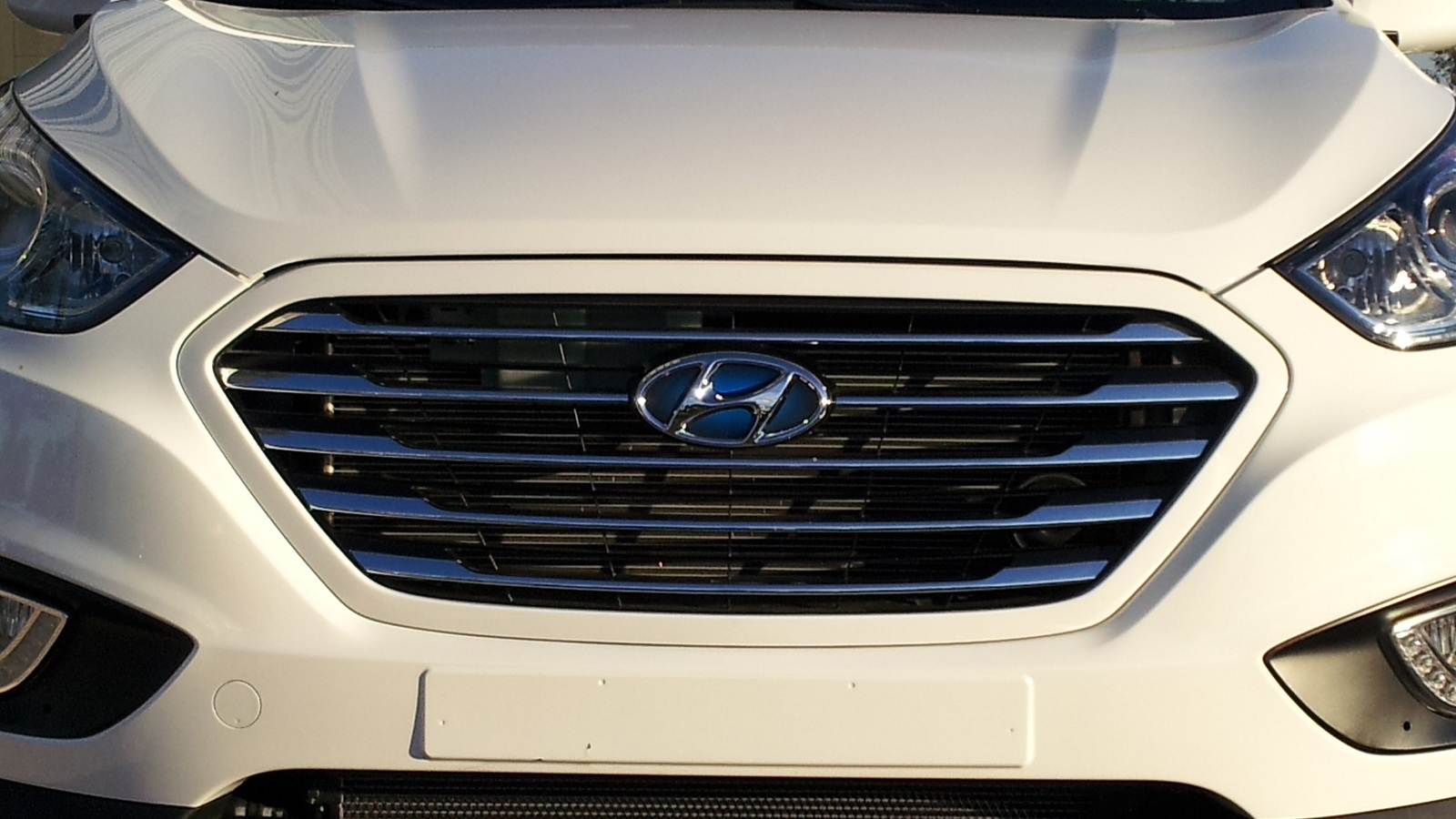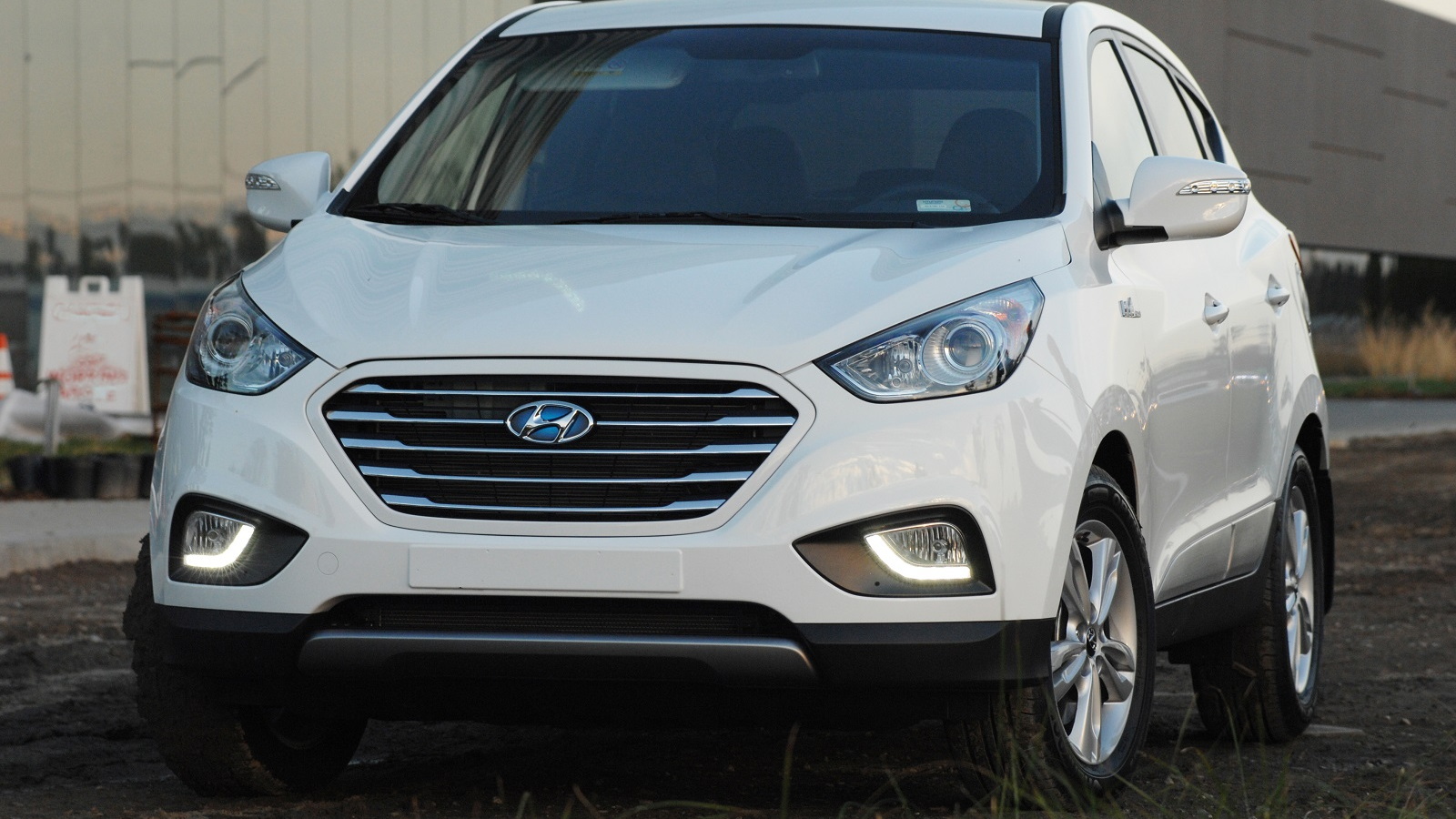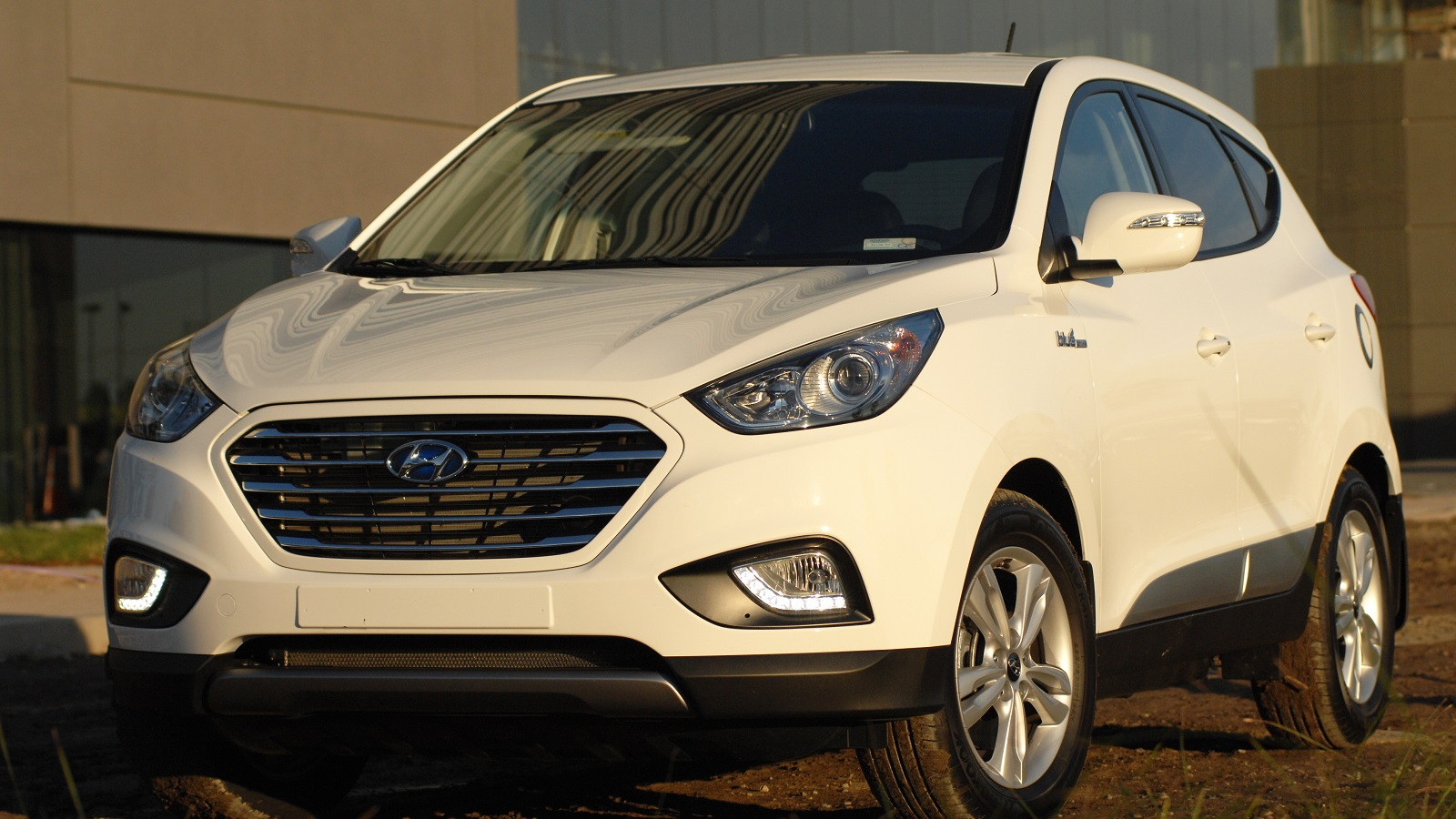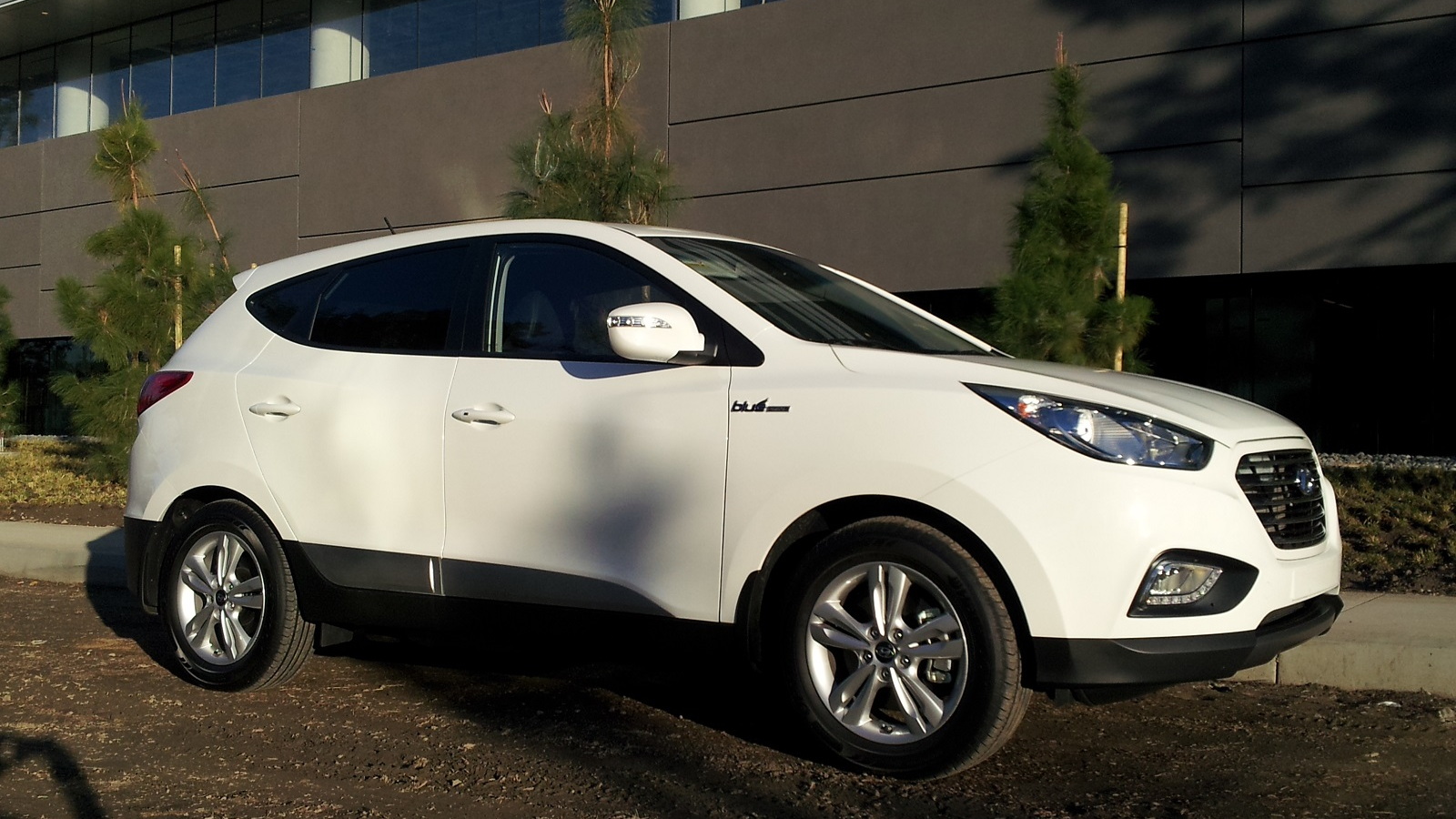Every so often, Hyundai posts an entry on its "Hyundai Like Sunday" blog, which promotes itself as "Truth, Candor and Conversation."
Two months ago, the company's Elizabeth Chun offered some thoughts on its upcoming 2015 Hyundai Tucson Fuel Cell compact crossover. That vehicle will be offered for lease this spring in selected markets in Southern California.
MORE: 2015 Hyundai Tucson Fuel Cell: Hydrogen Crossover First Drive
We drove the Tucson Fuel Cell in early December, and found it to be perfectly suitable for daily and long-distance use--though gutless at higher speeds--assuming hydrogen fuel were available.
Critical look
But it's worth diving into Hyundai's take on the pros and cons of hydrogen fuel-cell vehicles, to look critically at some of its assertions.
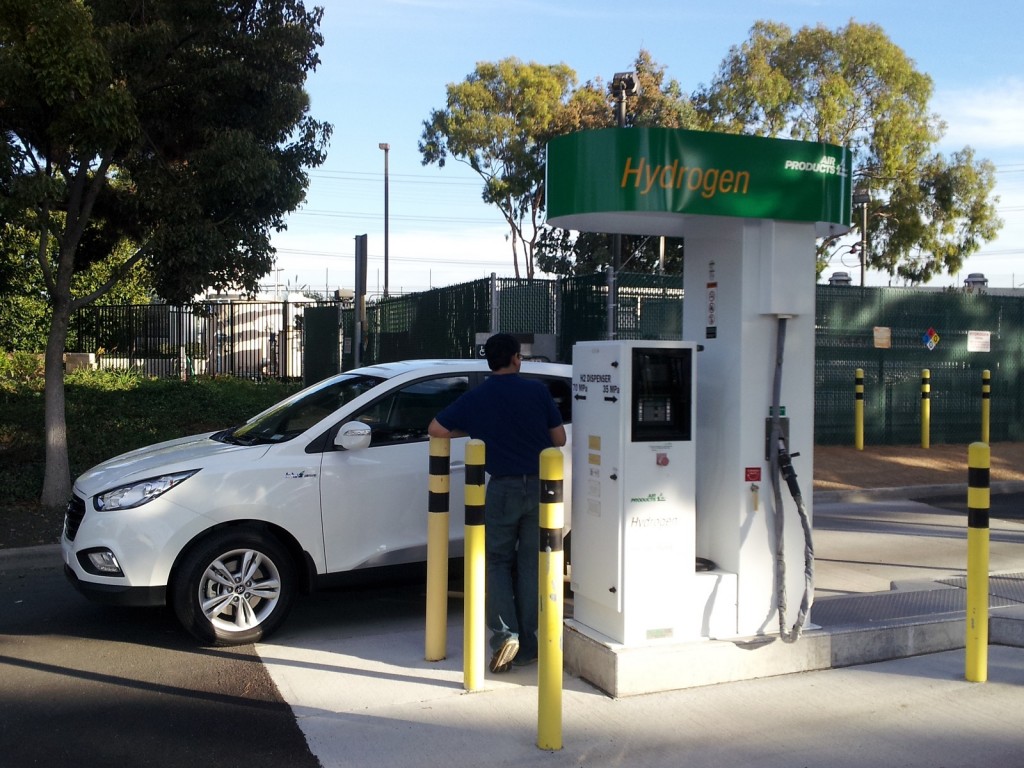
2015 Hyundai Tucson Fuel Cell at hydrogen fueling station, Fountain Valley, CA
The piece, Tucson Fuel Cell: The Next Generation Electric Vehicle, couches the hydrogen-powered Tucson as an electric car with a different energy source to power its electric drive motor.
[EDITOR'S NOTE: Hyundai Motors America contacted us to note that the post was written by now-departed CEO John Krafcik, and that Elizabeth Chun is the company's online content administrator.]
The author is careful to acknowledge that battery-electric technology "continues to improve and provides a viable alternative for some" users, but focuses on the "inherent slow-charge limitations" that she suggests limit battery-powered cars to a "distinct subset of car buyers."
That's arguably true for buyers who regularly travel more than, say, 75 miles a day and have no access to either workplace charging or DC fast-charging stations en route.

2015 Hyundai Tucson Fuel Cell at hydrogen fueling station, Fountain Valley, CA
Today, far more DC fast-charging locations are available than hydrogen fueling stations, though neither total comes remotely close to the 100,000-plus gas stations that blanket the U.S.
Build us hydrogen stations...
But Hyundai notes that the Tucson Fuel Cell will only be offered to "early adopters...in ZIP codes with easy access to hydrogen infrastructure."
The piece says this will limit sales of the vehicle, since the company sells a total of just 1,300 gasoline-powered Tucsons a year within those areas.
But, she says, it's more about a superb customer experience than high sales volume, and so Hyundai will pace itself "to the infrastructure that is being developed in parallel."
"We’re hoping the consumer interest we’re seeing already will help spark additional action among private companies and state and local governments," she writes, "to expedite infrastructure deployment."
In other words, Hyundai is saying, build us hydrogen stations and we'll provide the cars.

2015 Hyundai Tucson Fuel Cell at hydrogen fueling station, Fountain Valley, CA
Three main points
Then the author dives into the meat of the piece, noting that Hyundai spent time with "some of the deans of the green car journalist field" and asked about "the key battlegrounds" of the debate between grid-powered and hydrogen-fueled electric cars.
[EDITOR'S NOTE: Green Car Reports was one of several outlets Hyundai approached for the discussion that led to the piece. We saw and commented on a pre-publication draft of the Hyundai blog post. We did not know what the final post would say, nor when it would publish. This article is our response to the final version.]
The piece summarizes those issues in three statements:
- Grid-powered cars have lower wells-to-wheels greenhouse-gas emission than hydrogen-fueled cars;
- The cost of hydrogen infrastructure poses a fundamental barrier to widespread deployment of hydrogen vehicles; and
- Slow charging of plug-in cars is offset by the convenience of overnight home charging, impossible for hydrogen cars.
We think that's a fair summary of the main arguments.
New UC-Irvine study
Addressing the wells-to-wheels carbon footprint issue, the piece notes that a recent analysis by the Advanced Power and Energy Program, at the University of California at Irvine shows essentially equivalent greenhouse-gas emissions for hydrogen and battery vehicles when accounting for all inputs, including "feedstock, production, transmission and consumption."
Battery-powered vehicles have "a small advantage in California based on the cleaner grid here, while [fuel-cell vehicles have] a small advantage on a national basis," she continues.

2015 Hyundai Tucson Fuel Cell at Hyundai headquarters, Fountain Valley, CA
However, this summary might be viewed as selective data picking. On the available summary of the study, two graphs are shown. The second analyzes in detail the various methods of producing hydrogen fuel.
It's understandable that Hyundai would compare hydrogen cars to the U.S. grid as a whole. But if those cars will only be distributed in California in the near future, we might suggest that comparing to the California grid would be more valid.
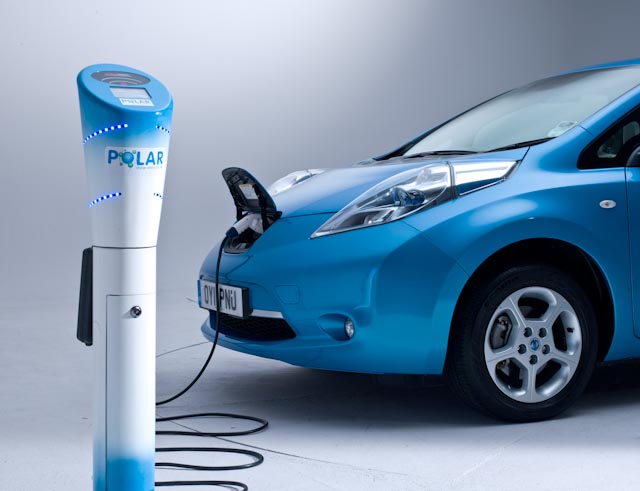
Polar Charging Post and Nissan Leaf
Using California's grid
In California (where fuel-cell vehicles will launch), battery-electric vehicles already have lower greenhouse-gas emission than hydrogen vehicles--unless the hydrogen is produced using (a) renewable energy; or (b) an experimental "BioGas Tri-Generation" method.
Using fully renewable energy to produce hydrogen lets plug-in proponents counter that each kilowatt-hour produces more miles traveled when you use it to recharge a battery that powers an electric drive motor.
Using it to make hydrogen by reforming natural gas--which must then be compressed, transported, compressed into the vehicle's tank, and turned back into electricity at no more than 60 percent efficiency in the fuel cell--is less efficient, and so will give you fewer miles traveled.
Fueling stations--on top of dumps?
As for the BioGas Tri-Generation method, you're presently limited to one fueling station in the country--the one in Fountain Valley, California, only a few miles from Hyundai's head offices.
To propagate that method requires not only building out a hydrogen fueling-station network, but seemingly doing so very close to biogas sites (aka former dumps) to avoid trucking or long-term pipeline transport for the hydrogen. That would seem to be quite a stringent additional site constraint.

2015 Hyundai Tucson Fuel Cell at Hyundai headquarters, Fountain Valley, CA
All that said, the news for both zero-emission vehicle technologies remains good.
"Importantly, both...solutions deliver more efficient total greenhouse-gas outputs than any other configuration," Hyundai's author concludes, including "high-mpg [combustion-engine] vehicles, natural gas variants, hybrids, and plug-in hybrids."
No gasoline early on, either
As for the infrastructure question, the author acknowledges the paucity of stations today, but notes that Germany plans to build 100 stations by 2018 and 400 by 2025.
And she alludes to a national effort to define "the best way to build a national refueling infrastructure" for hydrogen.
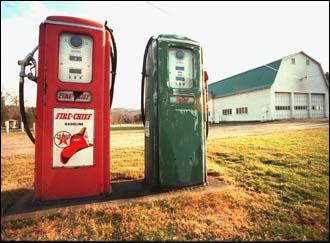
Old Gas Pumps
Suggesting that adoption of hydrogen fuel is "a marathon, not a sprint," she notes that there was no gasoline infrastructure when internal-combustion vehicles arrived, and that was built out over time.
Hydrogen will follow the same pattern, she says, and "over the next several years, more accessible hydrogen refueling will expand to over 35 million Californians and 80 million Germans."
Home charging: Yes, but
As for home charging, the piece acknowledges the security of spending 30 seconds to plug in and coming out the next morning to a fully recharged vehicle.
There's a but, though: "What about the many who don’t have a garage or access to overnight charging? What about those situations that take the driver away from home?"
Even if full national electric-car charging infrastructure were to be built, she asks, "How to build a national infrastructure of away-from-home charging in which charging vehicles must occupy a single physical space for long periods of time?"
![2013 Tesla Model S at Supercharger station in Woodburn, Oregon, Nov 2013 [photo: George Parrott] 2013 Tesla Model S at Supercharger station in Woodburn, Oregon, Nov 2013 [photo: George Parrott]](https://images.hgmsites.net/lrg/2013-tesla-model-s-at-tk-nov-2013-photo-george-parrott_100449151_l.jpg)
2013 Tesla Model S at Supercharger station in Woodburn, Oregon, Nov 2013 [photo: George Parrott]
There we might suggest that the writer differentiate between the lengthy times required for 240-Volt Level 2 charging and the 20 minutes required for an 80-percent recharge at a Tesla Supercharger DC quick-charging location.
That 20 minutes is only twice as long as the 10 minutes required to refill a Tucson Fuel Cell's empty hydrogen tank. Meanwhile, DC fast-charging users can walk away from their cars, while it's recommended that owners stay by their vehicles during gasoline and hydrogen fueling.
Kudos for civil discussion
In the end, we commend Hyundai for raising arguments, responding to them reasonably, and furthering the discussion on the basis of at least one study and civil discourse.
We wish more carmakers would do the same--Toyota and Honda, we're looking at you--and perhaps even bring together hydrogen proponents with some of the plug-in electric car buyers already out there.
Of whom there will be quarter of a million sometime this year, and counting.
Meanwhile, what do you think of Hyundai's arguments? If you're an electric-car proponent, can you see reasons to choose a hydrogen-fueled electric vehicle?
Leave us your thoughts in the Comments below.
_______________________________________________
